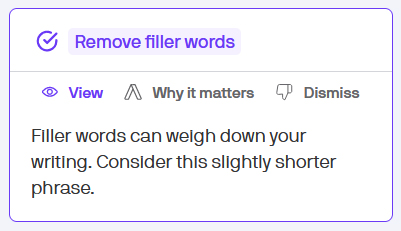
So-called “filler” words may not change a sentence’s meaning, but they can change the way you read it.
Less is more, they say. Brevity is the soul of wit. Or, as an A.I.-powered writing assistant might put it:

There are certainly times when cutting back on useless verbiage helps to streamline a sentence. But what if so-called “filler” words—words that don’t significantly alter the meaning of a sentence—can cue readers to the writer’s intended meaning?
When a jazz musician drops a note in a familiar standard, they don’t immediately move on to play the next note. They add a rest, and that gap becomes a part of the phrase, making it possible to identify the melody even in a drastically altered form. In writing, filler words may do the same: Like a rest, they may say nothing but still help to clarify the structure of the surrounding notes.
A few examples:
We all live with the possibility that our public embarrassments may be shared with millions of people online—especially now that there’s a camera on every doorbell and a smartphone in every hand.
That’s an acceptable sentence, in my view. But when an A.I. offered its (unsolicited) advice on the sentence this example is based on, it suggested the following:
We all live with the possibility that our public embarrassments may be shared with millions of people online now that there’s a camera on every doorbell and a smartphone in every hand.
You could argue that the meaning is technically the same, at least in terms of these sentences’ informational content. The emphasis, on the other hand, has completely changed; the eye is guided in a different direction. The first suggests a clear trend wherein the possibility of public embarrassment is rising as a direct result of more widespread surveillance, while the second example flatly states the fact of surveillance, muting the emphasis and obscuring the causal relationship.
Just as important is what this edit does to the sentence’s cadence. The dash and intensifier in the first sentence help to break up the sentence into two main ideas by inserting what is in effect a pause—a breath, if you will—between them. It cues the reader to the way these two ideas should be digested, and given the fact that the effect is introduced before the cause (with no “because” to connect them), that cue aids the reader’s comprehension. The dash makes it clearer how the two ideas are separated (and thus related). In the second example, they’re run together, and the distinction and relationship between the two ideas is muddled.
Both are comprehensible, yes, but one flows smoothly and the other is a puzzle to be solved. The filler word “especially” is a way to help readers see how they’re supposed to interpret a sentence as they’re reading it—as opposed to asking them to read to the end of the sentence and digest it as one enormous whole before they can understand how the individual pieces fit together. Of course, the longer a sentence is, the more onerous this becomes.
It’s also worth mentioning that this is how people naturally talk: Their thoughts come in spurts, and their delivery mirrors the way their brains are piecing meaning together into bundles for easier communication. When you listen to someone speak, their moments of hesitation, pauses for dramatic effect, and changes in volume, pitch, and overall intonation all help you interpret how their words should be reorganized. In writing, we have no such tools. What we do have are commas and other punctuation, italics, intensifiers, and, well, filler words.
By giving students both a firm foundation in math and science and an appreciation for arts and culture, we will nurture the type of citizens that can contribute to society and think critically about it, ultimately leading to more desirable economic and political outcomes.
Not the greatest sentence ever written, but it gets the job done. What if I told you an A.I. writing assistant suggested the following—in the name of “removing filler words”?
By giving students both a firm foundation in math and science and an appreciation for arts and culture, we will nurture the type of citizens that can contribute to society and think critically about it leading to more desirable economic and political outcomes.
Please ignore for a moment the fact that, in the second example, the A.I. removed the comma before a participial phrase (a blatant error) and focus on the deleted filler word, “ultimately.” Even beyond the effect mentioned above—the way the comma and “ultimately” signal a shift in meaning that helps the reader parse the sentence—“ultimately” is doing an important job. It defines the relationship between short-term and long-term goals, distinguishing means from ends. “Ultimately” does, in fact, change the way readers will interpret the sentence.
As a rule, it’s best to delete words that don’t add anything to a sentence. But keep in mind that when a writer chooses to add a “filler” word, it may be because it adds more than just syllables. It might also add to the sentence’s rhythm by helping to break it up into bite-sized, easy-to-digest pieces or clarify the hierarchy of its ideas—ultimately making for a much more pleasant reading experience.
One final point: A.I. makes these suggestions very quickly. But the person who has to vet them all? It probably took you a moment or two to parse the pairs of sentences above and determine which one is better. It goes without saying that you shouldn’t uncritically accept all of your A.I. copilot’s suggestions, given how spotty they are—and if you do take the time to weigh each one of an A.I.’s suggestions before accepting or rejecting it, then each rejected suggestion is time wasted.
So if you find yourself accepting most of an A.I.’s suggestions, great. But if it takes you longer to consider and reject all its misguided suggestions than it would take you to simply read the text and discover its faults for yourself, your proofreading A.I. may not be the time-saver it’s cracked up to be.


